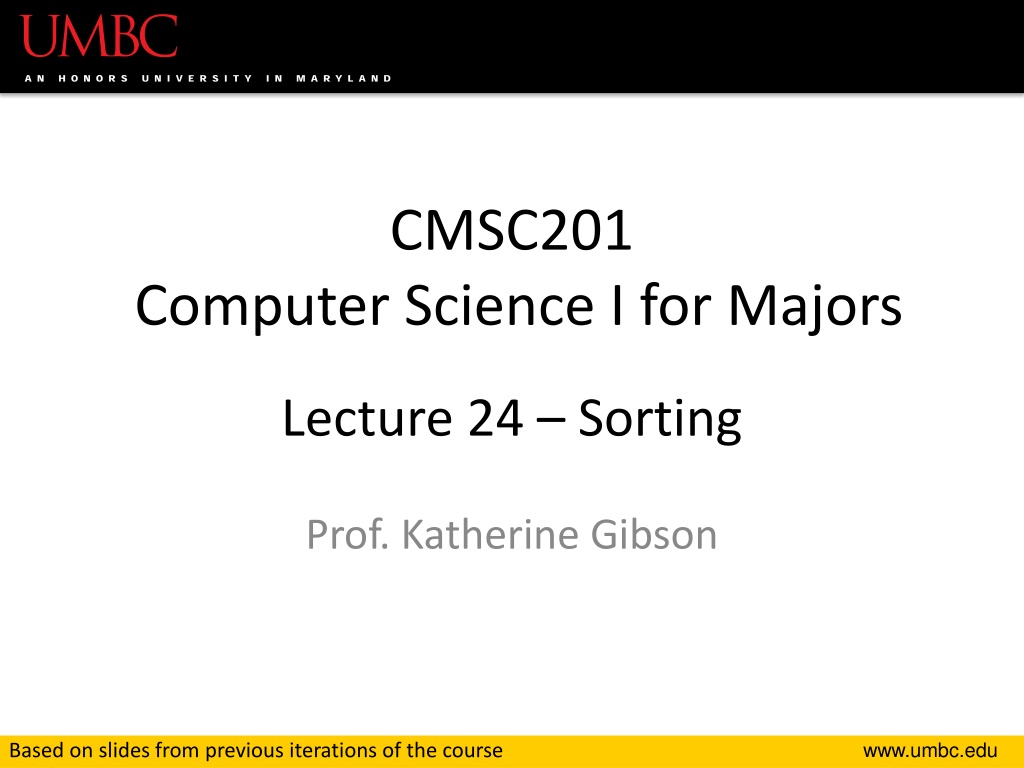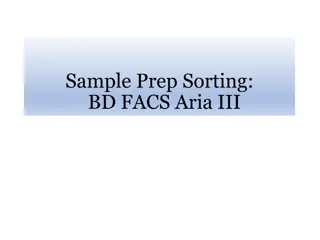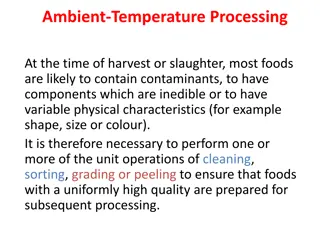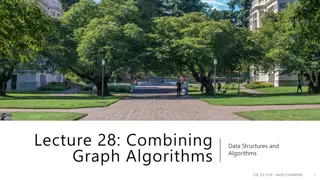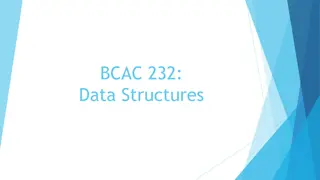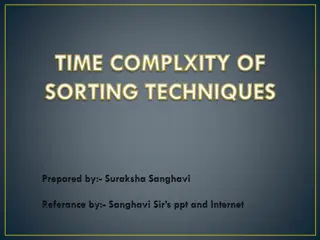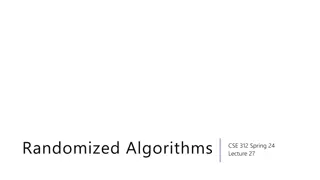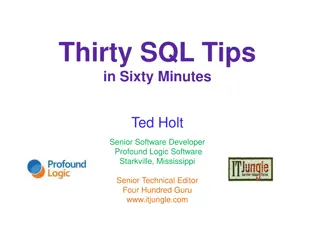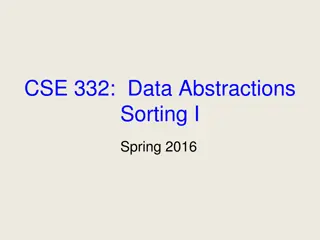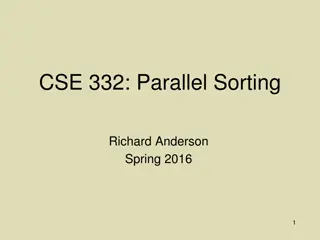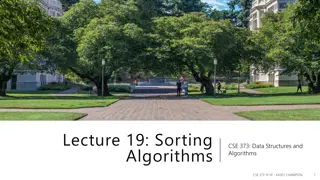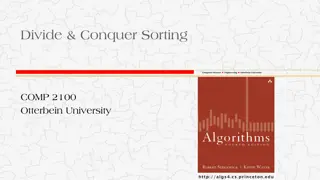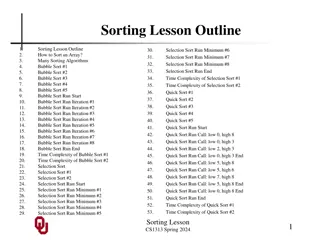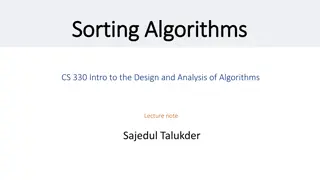Sorting Algorithms in Computer Science
Delve into the world of sorting algorithms in computer science with a focus on Selection Sort, Bubble Sort, Quick Sort, and Radix Sort. Learn how sorting impacts the efficiency of other algorithms and explore the scalability of different sorting methods. Discover the importance of sorting algorithms in organizing data for efficient retrieval and processing.
Download Presentation

Please find below an Image/Link to download the presentation.
The content on the website is provided AS IS for your information and personal use only. It may not be sold, licensed, or shared on other websites without obtaining consent from the author.If you encounter any issues during the download, it is possible that the publisher has removed the file from their server.
You are allowed to download the files provided on this website for personal or commercial use, subject to the condition that they are used lawfully. All files are the property of their respective owners.
The content on the website is provided AS IS for your information and personal use only. It may not be sold, licensed, or shared on other websites without obtaining consent from the author.
E N D
Presentation Transcript
CMSC201 Computer Science I for Majors Lecture 24 Sorting Prof. Katherine Gibson www.umbc.edu Based on slides from previous iterations of the course
Last Class We Covered Searching Linear search Binary search Asymptotic Performance How fast an algorithm runs Why certain algorithms are better than others 2 www.umbc.edu
Any Questions from Last Time? www.umbc.edu
Todays Objectives To learn about sorting algorithms Selection Sort Bubble Sort Quick Sort Radix Sort To examine which of these algorithms is best for different sorting situations How quickly do they scale? 4 www.umbc.edu
Sorting www.umbc.edu
Sorting Algorithms Sorting algorithms put the elements of a list in a specific order A sorted list is necessary to be able to use certain other algorithms Like binary search! If sorted once, we can search many, many times 6 www.umbc.edu
Sorting Algorithms There are many different ways to sort a list What method would you use? Now imagine you can only look at at most two elements at a time Computer science has a number of commonly used sorting algorithms 7 www.umbc.edu
Selection Sort www.umbc.edu
Selection Sort Algorithm Here is a simple way of sorting a list: 1. Find the smallest number in a list 2. Move that to the end of a new list 3. Repeat until the original list is empty 9 www.umbc.edu
Selection Sort Run Time What is the Big Oh of finding the lowest number in a list? For a list of size N, what is the worst case number of elements you d have to look through to find the min? N 10 www.umbc.edu
Selection Sort Run Time For a list of size N, how many times would we have to find the min to sort the list? N What is the Big Oh of this sorting algorithm? O(N2) 11 www.umbc.edu
Bubble Sort www.umbc.edu
Bubble Sort Algorithm Let s take a look at another sorting method! 1. We look at the first pair of items in the list, and if the first one is bigger than the second one, we swap them 2. Then we look at the second and third one and put them in order, and so on 3. Once we hit the end of the list, we start over at the beginning 4. Repeat until the list is sorted! 13 www.umbc.edu
Bubble Sort Example [ 4, 8, 1, 10, 13, 14, 6] First pass: 4 and 8 are in order 8 and 1 should be swapped: [ 4, 1, 8, 10, 13, 14, 6] 8 and 10 are in order 10 and 13 are in order 13 and 14 are in order 6 and 14 should be swapped: [ 4, 1, 8, 10, 13, 6, 14] 14 www.umbc.edu
Bubble Sort Example (Cont) [ 4, 1, 8, 10, 13, 6, 14] Second pass: 4 and 1 should be swapped: [ 1, 4, 8, 10, 13, 6, 14] 4 and 8 are in order 8 and 10 are in order 10 and 13 are in order 13 and 6 should be swapped: [ 1, 4, 8, 10, 6, 13, 14] 13 and 14 are in order 15 www.umbc.edu
Bubble Sort Example (Cont) [ 1, 4, 8, 10, 6, 13, 14] Third pass: 10 and 6 should be swapped: [ 1, 4, 8, 6, 10, 13, 14] Fourth pass: 8 and 6 should be swapped: [ 1, 4, 6, 8, 10, 13, 14] 16 www.umbc.edu
Bubble Sort Run Time For a list of size N, how much work do we do for a single pass? N How many passes will we have to do? N What is the Big Oh of Bubble Sort? O(N2) 17 www.umbc.edu
Quicksort www.umbc.edu
Quicksort Algorithm Here s another method: 1. Start with the number on the far right 2. Put everything less than that number on the left of it and everything greater than it on the right of it 3. Quicksort the left side and the right side Does this method remind you of anything? 19 www.umbc.edu
Quicksort Run Time For a list of size N, how many steps does it take to move everything less than the last number to the left and everything greater than the last number to the right? N 20 www.umbc.edu
Quicksort Run Time How many times with the algorithm divide the list in half? lg(N) What is the Big Oh of Bubble Sort? O(N lg(N)) 21 www.umbc.edu
Radix Sort www.umbc.edu
Improving Run Time Most of the time, O(Nlg(N)) is the best we can do for sorting However if we make the problem slightly easier, we can do even better! Imagine we know for a fact that the list we are sorting is only integers between 0 and 9 23 www.umbc.edu
Radix Sort Algorithm We can make a list of size 10 filled with zeroes The first element of this list represents the number of zeroes we ve seen so far in the list we re sorting The second number is the number of ones we ve seen, and so on 24 www.umbc.edu
Radix Sort Algorithm So say we have the list: [0, 3, 2, 1, 6, 8] We make our counting list: [0, 0, 0, 0, 0, 0, 0, 0, 0, 0] And iterate over the list we want to sort 25 www.umbc.edu
Radix Sort Algorithm The first number is a zero, so we add one to the zeroth element of our counting list: [1, 0, 0, 0, 0, 0, 0, 0, 0, 0] The next number is a 3, so we add one to the third element of our counting list: [1, 0, 0, 1, 0, 0, 0, 0, 0, 0] 26 www.umbc.edu
Radix Sort Algorithm Then 2: [1, 0, 1, 1, 0, 0, 0, 0, 0, 0] Then 1: [1, 1, 0, 1, 0, 0, 0, 0, 0, 0] When we re done, the list looks like this: [1, 1, 1, 1, 0, 0, 1, 0, 1, 0] 27 www.umbc.edu
Radix Sort Algorithm For an index i, we know that if countList[i] == 1, there was one i in the original list One pass over the counting list to figure out which numbers were there and we ve sorted it! 28 www.umbc.edu
Radix Sort Run Time How many operations do we need to do to fill out our counting list with zeros? N How many operations do we need to do to fill out our counting list with the right values? N 29 www.umbc.edu
Radix Sort Run Time How many operations do we need to do to reconstruct our sorted list? N This gives us a total run time of 3N operations So our final run time is simply O(N) 30 www.umbc.edu
Any Other Questions? www.umbc.edu
General Announcements Lab 12 this week last lab of the semester! Project 2 is out Due by Tuesday, December 8th at 8:59:59 PM Do NOT procrastinate! Next Class: Review for the Final 32 www.umbc.edu
Announcements: Final Exam Final Exam will held be on Friday, December 11th from 3:30 to 5:30 PM Being held in three separate rooms Section 1 (Gibson, MW @ 1) CHEM 030 Section 7 (Dixon, TR @ 5:30) CHEM 030 Section 13 (Dixon, TR @ 10) CHEM 030 Section 19 (Morawski, MW @ 4) PAHB 132 Section 25 (Gibson, TR @ 4) PHYS 101 Make sure you go to the correct room! 33 www.umbc.edu
Announcements: Surveys The second survey will be released and announced on Blackboard shortly This is 1% of your grade, and is your chance to give feedback on your experience with the course Now, we will be doing the in-class SCEQ (Student Course Evaluation Questionnaire) This is an important metric for assessment 34 www.umbc.edu
SCEQ Details Use only a #2 pencil Catalog number should be in top left corner Fill in the number of credits earned towards your degree at the beginning of the semester If less than 100, fill the two right-most columns If less than 10, fill the right-most column Fill in your cumulative GPA Fill unknown digits with 0 35 www.umbc.edu
SCEQ Details Fill in your officially declared major Computer Sci 63 Computer Eng 07 Information Sys 83 Applied Physics 62 Atmo Physics 41 Eng (General) 76 Chemical Eng 37 Biology 55 Math 61 Bioinformatics 98 If you haven t declared a major, enter 00 If yours isn t listed, raise your hand and I ll tell you 36 www.umbc.edu
SCEQ Details For this course, fill out the Scantron, sections: A (General) B (Lecture) Instructor A column only D (Laboratory) Fill out the Blue sheet Additional comments can be written on the back Bring completed sheets to the front 37 www.umbc.edu
